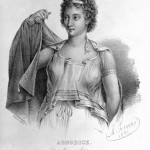By Helen King (Regular Contributor)
So there I was watching a superb drag burlesque act, The Down and Dirty Show, featuring The Gentleman King and Foxy Tann, the scheduled entertainment at the 2011 Berkshire Conference for Women Historians. And the sky opened. Sometimes moments of insight come when you least expect them.
How many times have you assumed that the person walking down the street in front of you was a man, and then when the person turned round you realized it was a woman? We read various cues, but then we have to change our minds. In this show, men became women who became men again in front of our eyes; which raised the question, were they men to begin with? Gender was most emphatically shown as something to be performed, meanings shifting with clothing and context, so that binaries dissolved and the world became a very different place.
And suddenly the imaginary ancient Greek midwife on whom I was writing a book, Agnodice, started to mean something very different. My main research question had never been the traditional one, namely ‘Was Agnodice a real person, a pioneering midwife who fought for the right of women to attend those giving birth?’ That question, the one asked by existing articles and books aimed at midwives, is I think a dead end. Of course this young girl, who is supposed to have disguised herself as a man to learn medicine and then practiced her profession until accused by jealous rivals, never existed. The story, culminating in her displaying her body to the court to prove she is really a woman and can’t have been seducing female patients, has many of the features of an ancient novel.
Having a ‘founding father’ for a profession is traditional, so claiming Agnodice as ‘first midwife’ just plays the same game as medicine and its specialisms: from Hippocrates as ‘father of medicine’ to Robert Koch as ‘father of microbiology’. Such games involve consolidating an identity for a newly emerging specialism, or making nationalist claims to precedence in a contested field. I was always more interested in how people over the last 500 years or so had refashioned Agnodice: was she, they wondered, a midwife or a female doctor? How that question has been answered can help us think today about debates over what midwifery is, how gender is relevant, and where the professional boundaries between midwives and doctors should be drawn.
One of the aspects of Agnodice in modern discourse that most fascinates me is her use in the name of the excellent Agnodice Foundation, a Swiss group working for the integration of those who are transsexual, intersex or transgender. I asked their founder, Dr Erika Volkmar, why Agnodice had been chosen. She was well aware that the story is a myth but replied that ‘We can assume that if Agnodice was successful in practicing OBG as a man, she must have been at least very androgyne and gender variant … Agnodice is perfect as she was both gender variant AND an outstanding professional. Equally, our foundation council is composed of a majority of great professionals with atypical gender identity. She is a model because as a gender variant person she obtained a major victory against the prejudice and sexism of our society, i.e. making medical studies accessible to women.’
The Agnodice Foundation is not the first to take Agnodice as gender variant. Here is James Sprague in 1912 imagining Agnodice speaking:
And so I reasoned, ’twas a blunder made, for which the gods were not responsible. Dame Nature ’twas who in erratic mood had linked a man’s mind to a woman’s form. And none suspected, none in all these years, the secret of my sex. Oh, strange indeed, the ways of gods are not like those of men — that by mere change of garb a woman is transformed into the semblance of a man, and that great inner difference concealed !
Her sex is female, in bodily terms, but here her mind is not. Would she have wanted to change her body to match her mind, had such an option been available to her? And it’s not just Agnodice’s mind that is male: for Sprague the court hears a voice whose full, rich, swelling tones were like unto an organ’s.
What The Down and Dirty Show showed me is that assuming that Agnodice was easily able to pass for a man because she was gender variant may make us miss an even larger point; namely, that gender is always potentially ambiguous. How do we read the signs? We assume we know who the boys are and who the girls are, but it only takes a change of dress or hairstyle or gesture and our carefully constructed binaries fall apart. Seeing Agnodice as gender variant glosses over the inadequacies of gender binaries, in history and today.
Sprague, James S., ‘Agnodice’, Dominion Monthly and Ontario Medical Journal, 38 (1912): 13–17.

